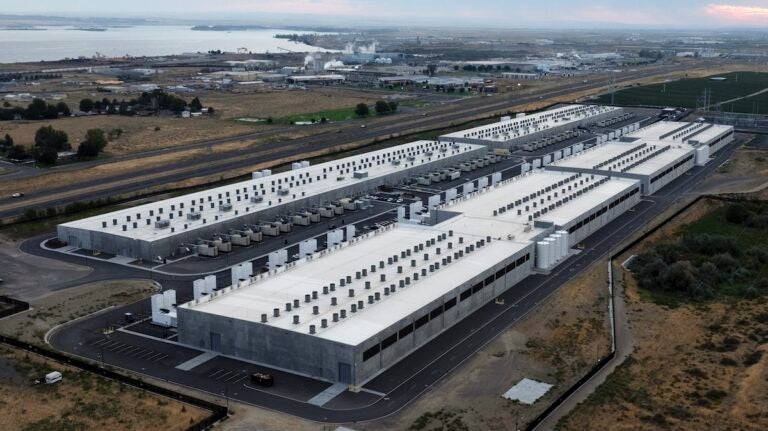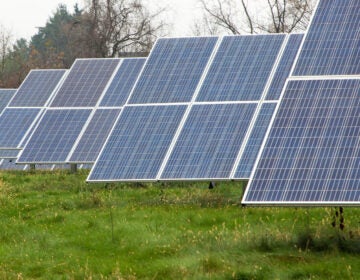Conshohocken-area residents push back against proposed data center
The facility would replace the recently closed Cleveland-Cliffs steel mill, which sits on 66 acres of land along the Schuylkill River.
Listen 1:24
Amazon Web Services data center is seen on Thursday, Aug. 22, 2024, in Boardman, Ore. (AP Photo/Jenny Kane)
This story is part of the WHYY News Climate Desk, bringing you news and solutions for our changing region.
From the Poconos to the Jersey Shore to the mouth of the Delaware Bay, what do you want to know about climate change? What would you like us to cover? Get in touch.
Some Conshocken-area residents are fighting back against a developer’s proposal to build a 2 million-square-foot data center one mile from the borough’s vibrant downtown area.
The facility would span 10 existing buildings at the recently closed Cleveland-Cliffs steel mill, which sits on 66 acres of land along the Schuylkill River.
Real estate mogul Brian O’Neill, who is steering the proposal, estimates the data center would generate $21 million a year in tax revenue. It’s not clear who would operate the facility, which O’Neill said would attract businesses to the area.
Earlier this month, Plymouth Township’s planning board unanimously refused to recommend the proposal to build the data center, which residents say could harm the environment and jack up energy bills. With the township’s zoning board scheduled to consider the proposal Nov. 17, some residents are gearing up with a petition that currently has more than 370 signatures.
“The Cleveland Cliff Steel Mill [has] been a huge part of our neighborhood and Conshohocken for many years, and it was sprung upon everyone very quickly that a developer was interested in a data center,” said Patti Smith, who started the petition and lives across the street from the site.
“We wanted to raise awareness, make sure that people were able to advocate for themselves because we don’t think that the local municipalities are ready to have these conversations and draft ordinances and regulations that can protect the residents.”
The demand for data centers
Data centers house the computer servers required to run internet services worldwide.
While they have been around since the mid-20th century, the acceleration of power-hungry artificial intelligence has boosted demand for larger sites and more resources.
Data center proponents say the facilities are essential for enabling connectivity and innovation across business and industry, and claim they create hundreds of jobs and generate millions of dollars in tax revenue.
However, many residents and environmentalists say the potential rewards don’t outweigh the risks. Data centers use a significant amount of energy and as AI requires more power at a faster rate than typical internet activities, data centers often strain the power grid, leading to increased electricity rates for consumers.
A 2024 Department of Energy report on U.S. data center energy use estimated that data center load growth tripled over the past decade, and would double or triple again by 2028.
Data centers also require substantial water consumption to cool servers that are at risk of overheating, as well as for offsite power generation and component manufacturing. By 2028, hyperscale data centers across the U.S. are expected to consume between 60 and 124 billion liters of water.
O’Neill did not respond to a request to answer questions about the proposed Conshohocken data center, which would generate its own energy rather than relying completely on the grid.
However, during a Plymouth Township hearing on the proposed data center, he said his goal is to “rethink the Plymouth Industrial District,” and “put 21st century industry in an industrial building that exists today.”
O’Neill’s vision comes as federal and state lawmakers aim to pave the way for data center development in an effort to ramp up tax revenue.
In June, Pennsylvania Gov. Josh Shapiro announced his support for Amazon’s $20 billion investment in developing data centers across the state, including a 1 million-square-foot Amazon facility in Bucks County. One month later, the Trump administration announced plans to accelerate AI development with limited regulatory oversight.
Lawmakers in Pennsylvania are considering legislation that aims to transfer land use authority from local municipalities to an energy board in order to fast-track data center projects, and to speed up the permitting process for data centers while restricting local zoning. State legislators are holding a public hearing Wednesday for a bill that would establish a regulatory framework for data centers operating in Pennsylvania.
Residents’ growing concerns over environmental impacts
The demand for data centers has panicked some Pennsylvania residents who fear they will be hit with higher energy bills. Most of these facilities rely on the electrical grid, which in the Philadelphia region is managed by PJM Interconnection. PJM has pointed to the increase in data centers as a reason for strain on the grid.
Residents in the region have already been hit with increased energy bills, and PJM’s recent capacity auction — where power plants bid for rates in exchange for guaranteeing future supplies — resulted in an expectation that those rates will rise another 1.5% to 5%.
Though a 2023 Department of Energy study said data centers amount to less than 5% of annual electricity use in the U.S., the same report indicates data centers will consume 6.7% to 12% of total U.S. electricity by 2028.
“At that rate we simply can’t build enough power generation to keep up, so prices will continue to rise rapidly,” said Tom Schuster, president of the Pennsylvania chapter of the Sierra Club.
“Aside from all of that, these facilities want to run full bore, 24/7, 365, even when power supplies are constrained due to extreme weather, or for any other reason really, and when there’s no excess generating capacity on the grid, there’s no room for error if a power plant goes down or something goes wrong with the grid.”
O’Neill said at the October hearing that the proposed data center in Conshohocken would utilize natural gas to generate its own energy, which he argues would reduce the impact on the electric grid.
Although the large facility would require the use of well water sourced from the Schuylkill River, O’Neill said operators would recycle and reuse the water to reduce its strain on water supplies. Larger data centers can consume up to 5 million gallons of water per day and, in some areas, have drained resident’s well water supplies.
However, opponents of the proposal have other concerns. Natural gas generation can release greenhouse gases, such as carbon dioxide and methane, which contribute to climate change.
The petitioners say they’re concerned the natural gas turbines required to produce energy would also create noise and air pollution, impacting residents, as well as hikers and cyclists who use the Schuylkill River Trail.
“The direct impact on our air is my biggest concern,” said Genevieve Boland, who is leading the petition alongside Smith, her roommate. “There is plenty of research, plenty of data out there that clearly shows causation of higher risks of cancer, of respiratory issues, asthma, allergies, you name it.”
O’Neill said the data center would also utilize backup generators that would be made available to the grid during times of high demand. However, Schuster said generators are not strictly regulated and have minimal pollution controls.
“They often run on diesel and they can be very polluting,” he said, adding that a data center of that size would use dozens of generators at a time. “If those things are running all at the same time, they’re going to be creating a very large amount of local pollution. Diesel particulate pollution is very bad for peoples’ health, and if you’re doing that during times of high electricity demand, that tends to happen on hot summer days when air quality is already bad.”
Smith and Boland said that until the township revisits the proposal next month, they’re hoping to spread the word to their neighbors as much as possible.
“Our immediate next steps are to drum up as much attention to this as we can in the community because I feel like there are still people in Plymouth Township who are not aware of this,” Smith said. “That is the most important part, is to be able to have the community speak for themselves.”

Get daily updates from WHYY News!
WHYY is your source for fact-based, in-depth journalism and information. As a nonprofit organization, we rely on financial support from readers like you. Please give today.







